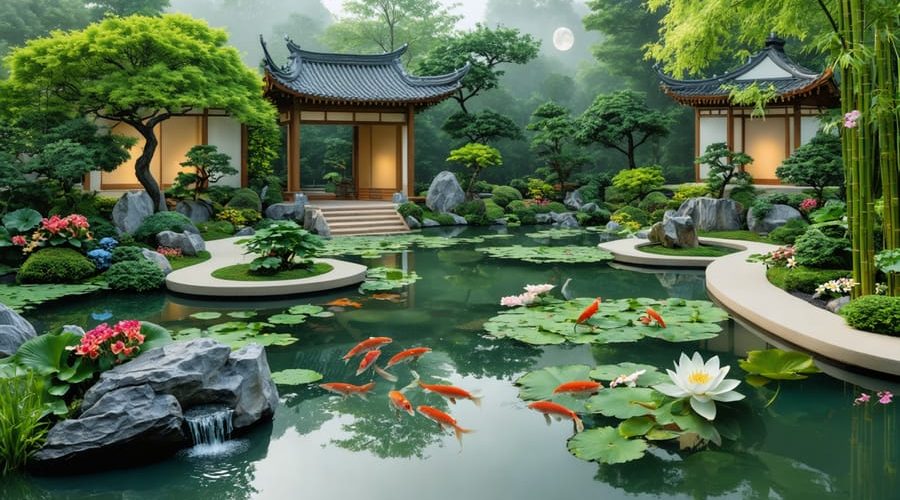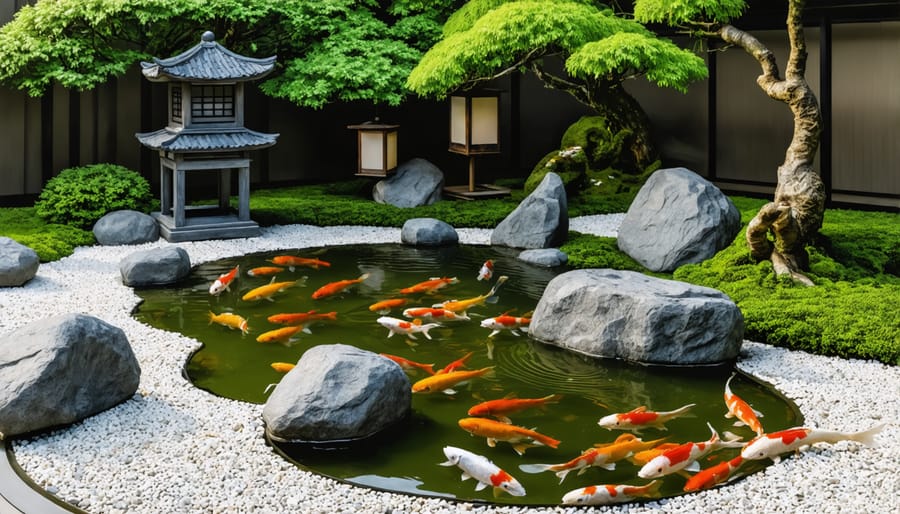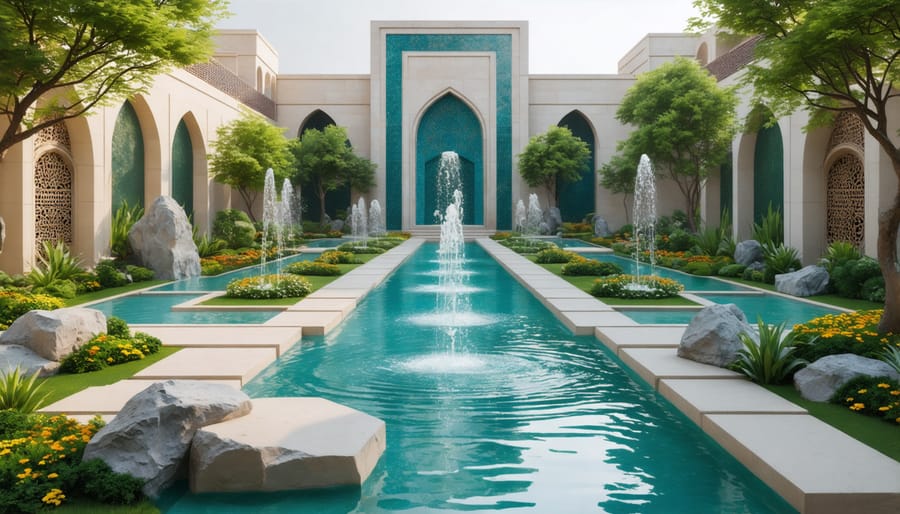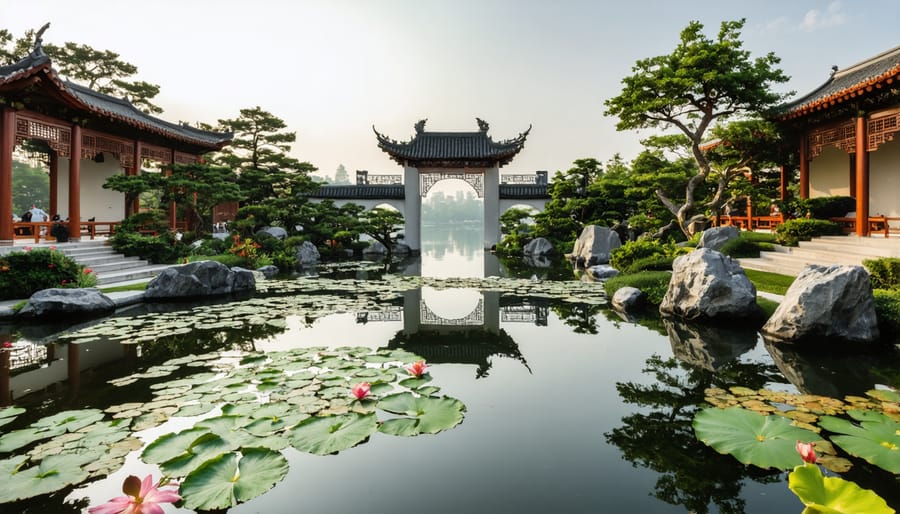
How Ancient Water Gardens Are Transforming Modern Pond Design
Transform your garden into a global sanctuary by blending elements from diverse water garden traditions. The historical water garden evolution across continents offers countless opportunities to create unique aquatic spaces that transcend cultural boundaries.
Japanese zen gardens teach us to incorporate negative space and careful rock placement, while Persian paradise gardens demonstrate how to use flowing water features to create cooling sanctuaries. Mediterranean traditions show us how to combine water elements with drought-resistant plants, creating sustainable beauty that honors multiple cultural perspectives.
By embracing intercultural exchange in your water garden, you’re not just designing a beautiful space – you’re participating in a centuries-old tradition of borrowing and adapting design elements across borders. Whether you’re adding a Chinese-inspired moon gate beside your koi pond or integrating Islamic geometric patterns into your fountain design, each cultural element brings its own symbolism and practical wisdom to your garden.
This guide will help you thoughtfully blend different cultural influences while respecting their origins, creating a harmonious space that celebrates global garden traditions while remaining uniquely yours.
Eastern Influences: Japanese Garden Wisdom
Zen Elements in Modern Ponds
Modern pond design has been profoundly influenced by Japanese water garden traditions, bringing timeless Zen principles into contemporary outdoor spaces. These elements create peaceful havens that feel both ancient and fresh, perfect for today’s busy homeowners seeking tranquility.
Key Zen concepts like simplicity and balance are easy to incorporate into your pond design. Start with clean lines and uncluttered spaces around your water feature. Choose rocks and stones thoughtfully, placing them in odd-numbered groupings to create natural-looking arrangements. A single well-placed boulder can serve as a striking focal point, while smaller stones create gentle transitions between water and land.
Water flow in Zen-inspired ponds tends to be subtle and peaceful. Instead of dramatic waterfalls, consider gentle cascades or simple bamboo spouts that create soft, meditative sounds. Plant choices typically feature simple, clean varieties like rushes and iris, rather than showy blooms.
The Japanese principle of “ma” – the conscious use of negative space – can transform your pond area. Leave open areas around key features to let them breathe and stand out. This approach not only looks beautiful but also makes maintenance easier and creates peaceful viewing spots where you can pause and reflect.
Remember, you don’t need to recreate an exact Japanese garden – even incorporating a few of these elements can bring that sought-after sense of calm to your outdoor space.

Koi Culture’s Global Impact
Koi keeping has transcended its Japanese origins to become a global phenomenon, influencing pond design and water gardening practices worldwide. What started as a symbol of status and beauty in Japan has evolved into a beloved hobby that spans continents, with dedicated koi clubs and societies flourishing from Europe to the Americas.
The international adoption of koi culture has led to innovative developments in pond design, with enthusiasts incorporating traditional Japanese elements while adapting to local conditions. Modern koi ponds often feature a blend of Eastern aesthetics, such as rock arrangements and wooden bridges, with Western technological advances in filtration and water management.
This cultural fusion has sparked creativity in outdoor living spaces, where homeowners increasingly view koi ponds as focal points for relaxation and entertainment. The influence extends beyond just the ponds themselves – surrounding gardens often incorporate Japanese-inspired elements like stone lanterns, bamboo fountains, and carefully pruned plants, creating harmonious outdoor spaces that reflect this cross-cultural appreciation.
The global koi community has also fostered international relationships through koi shows, breeding programs, and knowledge sharing. These connections have not only elevated the standards of koi keeping but have also deepened the understanding and appreciation of Japanese garden principles worldwide, making water gardens more sophisticated and meaningful spaces for enthusiasts of all backgrounds.
Persian Paradise Gardens Reimagined

Modern Water Features
Today’s garden designers are breathing new life into traditional Persian water features, creating stunning modern interpretations that honor their historical roots. The ancient concept of the chadar – a gently sloping, textured water wall – has evolved into contemporary vertical water features that create soothing sounds and cooling effects in urban spaces. These updated versions often incorporate LED lighting and sustainable materials while maintaining the mesmerizing ripple patterns that made the originals so captivating.
The traditional Persian paradise garden layout, with its four-channel water system, has inspired modern reflecting pools and geometric water features that bring serenity to both public and private spaces. Designers are reimagining these classic elements using eco-friendly materials and energy-efficient pumps, making them more sustainable for today’s gardens.
Many homeowners are now incorporating miniature versions of Persian-style channels and fountains into their outdoor spaces. These scaled-down adaptations use modern materials like polished concrete or stainless steel, while maintaining the original principles of water movement and sound. Some creative interpretations include wall-mounted water features that mimic traditional patterns, and small courtyard fountains that capture the essence of Persian design in a contemporary context.
Smart technology has also found its way into these cultural adaptations, with automated water level controls and programmable flow patterns that help conserve water while maintaining the visual and auditory appeal that made Persian water features so beloved throughout history.
Sustainable Water Management
Ancient Persians were masters of water conservation, developing ingenious systems like the qanat underground aqueducts and beautifully designed gardens known as paradise gardens. Today, these time-tested techniques offer fantastic solutions for modern water gardening challenges.
One of the most practical Persian innovations we can adopt is the strategic use of shade and water channels. By creating narrow waterways that flow through shaded areas, you’ll reduce water evaporation while creating stunning visual effects. Try incorporating pergolas or tall plants along your water features to achieve this dual benefit.
The Persian principle of water recycling is another game-changer for contemporary gardens. Instead of letting water flow away, design your garden with gentle slopes that guide water back to a central collection point. This creates a sustainable cycle that ancient Persian engineers would definitely approve of!
Paradise gardens traditionally featured four-part designs with water at the center. You can adapt this concept by dividing your garden into quarters with intersecting water channels, even on a smaller scale. Add native plants along the waterways to boost efficiency and create habitat for local wildlife.
For those in drought-prone areas, consider the Persian technique of underground water storage. While we might not build elaborate qanats, you can install modern rain barrels or underground cisterns to capture and store rainwater for drier periods.
Chinese Garden Elements in Western Design
Balanced Design Principles
Feng shui principles teach us that water brings positive energy and prosperity when properly positioned in our gardens. In Chinese garden design, the flow of energy, or ‘qi,’ is enhanced through thoughtful placement of water features and surrounding elements. Creating balanced water garden ecosystems starts with understanding these ancient principles.
Consider positioning your pond in the north or east of your garden, which traditionally represents career growth and family harmony. Gentle curves and meandering paths around your water feature are preferred over straight lines, mimicking nature’s organic flow. This design approach not only looks more pleasing but also creates a sense of discovery as visitors explore your garden.
Incorporate the principle of borrowed scenery (jiejing) by positioning your pond to reflect nearby trees or architectural features. This technique makes your space feel larger and more connected to its surroundings. Balance yin (soft, flowing) elements like water with yang (solid, structural) features such as rocks or decorative bridges.
Remember to include places for quiet contemplation, such as a small seating area beside your pond. Traditional Chinese gardens always provide spaces for reflection and meditation. Add classic elements like water lilies or lotus flowers, which carry deep symbolic meaning while contributing to the garden’s natural balance. These time-tested design principles help create a harmonious space that feels both grounded and uplifting.
Aquatic Plant Selection
Chinese aquatic plants have made a significant splash in Western water gardens, bringing with them centuries of cultural symbolism and practical beauty. The lotus flower, revered in Chinese culture for its purity and enlightenment, has become increasingly popular in Western pond designs. Its large, dramatic blooms and distinctive circular leaves create stunning focal points while adding a touch of Eastern elegance to any water feature.
Water lilies, particularly hardy varieties developed from Chinese species, have adapted wonderfully to Western climates. These plants offer both aesthetic appeal and practical benefits, helping to maintain pond health by providing shade and reducing algae growth. The sacred lotus (Nelumbo nucifera) has proven particularly successful in temperate zones, thriving in still waters and offering spectacular pink or white blooms throughout summer.
Chinese rush (Juncus effusus) has become a staple in modern water gardens, valued for its architectural form and low maintenance requirements. This versatile plant works beautifully along pond edges or in shallow water, creating natural transitions between water and land. Another Chinese favorite gaining traction is water bamboo (Zizania latifolia), which adds vertical interest and creates wonderful movement in the breeze.
Beyond their ornamental value, these plants bring traditional Chinese garden principles of harmony and balance to Western landscapes. Many gardeners are discovering that incorporating these elements helps create more peaceful, contemplative spaces that bridge cultural traditions while maintaining ecological balance in their water gardens.

Creating Your Cross-Cultural Water Garden
Creating a cross-cultural water garden is like composing a beautiful symphony where elements from different traditions harmonize to create something uniquely yours. Start by selecting a focal point that draws from one cultural tradition – perhaps a Japanese stone lantern or a European tiered fountain – and build your design around it.
Consider incorporating these cultural elements thoughtfully: Add Asian influences with carefully positioned rocks and small islands, which represent mountains and land masses in Japanese gardens. Include lotus flowers or water lilies, which hold deep significance in both Eastern and Indian traditions. Mediterranean touches can come from terra cotta pots planted with herbs along the water’s edge or classical-style statuary.
When mixing elements, aim for balance rather than cramming in too many features. A good rule of thumb is to choose two or three cultural influences that naturally complement each other. For example, combine Chinese garden bridges with English marginal plants, or pair Mexican talavera pottery with Mediterranean water spouts.
Pay attention to the flow of your garden. Middle Eastern designs often emphasize the sound and movement of water, which you can achieve through small waterfalls or fountain features. Create contemplative spaces with flat stones or benches positioned to view the water, a practice valued in many Asian gardens.
Plant selection offers another opportunity for cultural fusion. Mix native species with traditional plants from other regions, ensuring they’re suitable for your climate. Consider Chinese water bamboo alongside European marsh marigolds, or Japanese iris next to American cardinal flowers.
Don’t forget about lighting, which can dramatically transform your garden’s atmosphere. Chinese lanterns, Moroccan glass lamps, or European garden sconces can add magical evening ambiance while reflecting different cultural aesthetics.
Remember that authentic cross-cultural design isn’t about random placement of objects from different traditions. Instead, focus on understanding the principles behind each cultural element and how they can work together. Consider the meaning behind each addition – like the serenity of a Buddhist water bowl or the playful spirit of an Italian putto fountain.
Finally, make the space personal by incorporating elements from your own cultural background or travels. This personal connection will make your water garden not just a display of different traditions, but a meaningful reflection of your own journey through various cultural influences.
The beauty of water garden design lies in its ability to transcend cultural boundaries and create spaces that celebrate our global heritage. By incorporating elements from various cultural traditions, we enrich our gardens with deeper meaning and unique aesthetic appeal. Japanese zen gardens teach us the value of simplicity and meditation, while Persian paradise gardens demonstrate how water features can transform arid spaces into lush retreats. Italian Renaissance influences remind us that water gardens can be both grand and intimate, perfect for entertaining or quiet contemplation.
These cultural exchanges do more than just enhance the visual appeal of our gardens – they foster understanding and appreciation for different traditions and ways of thinking. When we incorporate a Chinese moon gate or add Mediterranean pottery to our pond edges, we’re not just decorating; we’re creating connections to centuries of gardening wisdom.
The fusion of different cultural elements in modern water gardens shows how traditional designs can evolve to meet contemporary needs while preserving their essential character. Whether you’re adding a modest fountain inspired by Moorish designs or creating an entire Asian-inspired water garden, these cultural borrowings add depth and personality to your outdoor space.
Remember that successful cultural exchange in garden design isn’t about exact replication, but rather thoughtful adaptation. By understanding and respecting the principles behind different cultural traditions, we can create water gardens that are both authentic and personally meaningful, bridging past and present in our own backyards.
